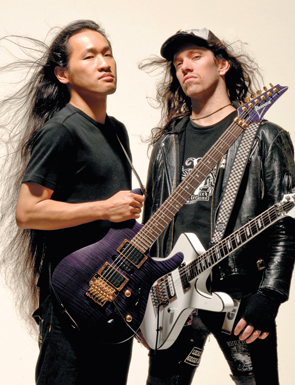Art of Shredding: Dragonforce

Originally published in Guitar World, December 2010
Dragonforce's Herman Li and Sam Totman sit down with Guitar World to discuss shred guitar.
For flat-out, unapologetic soloing, who blows your mind?
SAM TOTMAN I was always a big fan of Chuck Schuldiner, especially on Death's Spiritual Healing. I think the solo work on that album between him and James Murphy is probably my favorite album for lead guitar.
HERMAN LI I have been building up a large shred-guitar music collection for years, so I've heard a lot of great playing and it's really hard for me to pick just one. But George Lynch has always impressed me with his unpredictable approach to soloing, and Jason Becker's Perpetual Burn album is just pure shred awesomeness.
What album/song inspired you to play fast?
TOTMAN Basically, any thrash or death metal album. Those have always been two of my favorite music styles.
All the latest guitar news, interviews, lessons, reviews, deals and more, direct to your inbox!
LI One album that really gave me the drive to learn to play fast was Dream Theater's Images and Words. At the time I was already listening to a lot of guitar instrumental albums and had seen plenty of instructional videos, but Images and Words was the one that broke down the doors for me. I felt like, Okay, I get it now! Maybe it was the way John Petrucci's guitar solos were composed, because his use of speed along with melodies really made total sense to me.
What helped you progress dramatically as a guitarist?
TOTMAN I started playing classical guitar when I was around 10 years old, and I ended up going to study it at university, so obviously there was a lot of practice involved there. Once I discovered metal and rock music, I was able to use a lot of the skills I already had, but by that point I already had the physical ability to move my fingers fast and keep in time.
LI Watching instructional guitar videos and practicing my improvisation over my favorite CDs really helped me to progress quickly at the beginning. After three years of playing, I was able to play a few Steve Vai, Joe Satriani and Tony MacAlpine songs pretty well, just from learning by ear.
I used to watch a lot of videos to see the different theory and approach of the guitar instead of learning the licks. Then I would try to see what worked for me, applying it through improvisation over CDs I like. Because I got to play along to music I enjoyed, it was always fun. And at the same time, I learned to play in key and in time with the band. I used to do that for at least three to four hours each day.
What was your biggest technical hurdle?
LI Most of the instructional tapes I watched when I was starting out only taught guitarists how to play sitting down. Of course when you stand up, everything changes, but performing in front of an audience is something else. You need to look animated and show that you mean everything you play, but at the same time relax and let the music flow through you. So after I watched a lot of live videos, I realized that I had to relearn every technique to be able to do it in at least one or more different ways for future live performances. It was a lot of work, but playing guitar iive with a band is probably what I love to do most.
What key performance in your discography is a successful example of what you try to achieve?
TOTMAN One moment I remember pretty clearly is when we finished our Sonic Firestorm album. I think that was the moment when I realized I had really written something quite original and made the album that I had been trying to make since we first started the band.
LI "Fury of the Storm" from our second album, Sonic Firestorm, has Dragonforce's signature sound all over it. It was kind of a statement for us. It showed everybody that we play exactly the way we want to—no compromises. We believe in our art.
Is shredding a good thing?
TOTMAN It's good! I guess everyone has different reasons why they like it. But personally I just think it sounds cool, and I also find it quite funny for some reason.
LI It is one of the most fun things to do on the guitar. After all the hard work put in practicing and learning, it's time to go full out and show them what you've got. No matter what you do, there will always be haters and people complaining about it. Don't ever let that stop you. Do what you love.
What are you currently working on, and what is your goal as a player?
LI Right now I'm working on a lot of new musical ideas and sharpening up all my skills by going through licks, scales, arpeggios and techniques I haven't used in a long time. I'm kind of going back to basics and reworking my way up, refreshing everything I've learned before but may have forgotten. I've been doing that for a week now, and I can see a lot of improvement in different areas of my playing. I just want to constantly improve myself as much as possible in all areas of the guitar and beyond. There are so many things to do and learn. I can never be bored. I just love the guitar.
